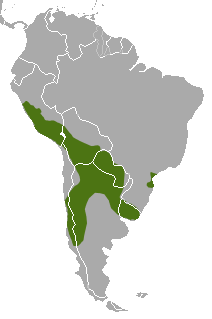Andean skunk
| Andean skunk | ||||||||||||
|---|---|---|---|---|---|---|---|---|---|---|---|---|

Andean skunk ( Conepatus chinga ) |
||||||||||||
| Systematics | ||||||||||||
|
||||||||||||
| Scientific name | ||||||||||||
| Conepatus chinga | ||||||||||||
| ( Molina , 1782) |
The Andes Skunk ( Conepatus chinga ) is one of four kinds of the hog-nosed skunk within known as "skunk" skunk . It is common in parts of South America from Peru to Argentina.
features
The Andean Skunk reaches a total length of about 46 to 90 centimeters, the females are usually slightly smaller than the males. The weight is around 2.3 to 4.5 kilograms. They have a bare protruding nose.
The fur of the Andean Skunk is black with two white stripes that extend from the neck to the largely white tail. A white facial drawing is missing.
You are loner.
Diet and natural enemies
Andean skunks hunt insects, small vertebrates such as rodents, lizards and snakes.
The Andean Skunk has a kind of immunity to the venom of pit vipers .
distribution
The Andean Skunk is common in central to southern South America. The distribution area extends from the Andes in southern Peru via Bolivia and western Paraguay to Uruguay , Chile and Argentina , where it can be found up to the province of Neuquén . The species has also been identified from the region around São Paulo , Paraná and Santa Catarina in southern Brazil .
This Skunk prefers open steppe areas and scree areas in dry (arid) areas and regions characterized by bushes. He lives in crevices, hollow trees or buildings that have been abandoned by other animals.
Systematics
|
Phylogenetic systematics of the Skunks
|
The Andean Skunk is classified as an independent species within the genus of the White -legged Skunk ( Conepatus ), which consists of four species. The first scientific description comes from Juan Ignacio Molina from 1782 on the basis of an individual from the area around Valparaíso . Within the species, seven subspecies are distinguished with the nominate form Conepatus chinga chinga and Conepatus chinga budini , Conepatus chinga gibsoni , Conepatus chinga inca , Conepatus chinga mendosus , Conepatus chinga rex and Conepatus chinga suffocans . Conepatus chinga rex was at times considered synonymous with Conepatus chinga chinga .
The Andean skunk is the sister species of the piglet skunk ( Conepatus leuconotus ) within the Belarusian skunk , these two species are compared to the remaining species Patagonian skunk ( Conepatus humboldtii ) and Amazon skunk ( Conepatus semistriatus ) as a common taxon . In their entirety, the Belarusian Skunks represent the sister group of the genera of the Striped Skunks ( Mephitis ) and Fleckenskunks ( Spilogale ), which are common in North and Central America . The radiation of the species within the Belarusian Skunk took place about 11.2 million years ago. This resulted in immigration to the South American continent long before the Central American land bridge was formed about 3 million years ago.
Hazard and protection
The Andean Skunk is classified by the International Union for Conservation of Nature and Natural Resources (IUCN) as not endangered ("least concern") due to its relatively large distribution area as well as the assumed stable stocks and the comparatively little changed habitats. Both the decline in the number of animals due to hunting and loss of habitat currently represent such a high risk that classification in a risk category is necessary.
The species is primarily endangered by the heavy hunt, especially when it comes to obtaining skunk skins . This peaked in Argentina in the 1970s and 1980s. In addition, there is a sometimes severe degradation, especially of the extensively usable steppe areas of Patagonia, due to overgrazing and soil erosion .
supporting documents
- ^ A b c Kevin Afflerbaugh: Conepatus chinga in the Animal Diversity Web of the University of Michigan Museum of Zoology. Retrieved December 29, 2011.
- ↑ a b c d Conepatus chinga in the endangered Red List species the IUCN 2008. Posted by: L. Emmons, K. slipway, K., 2008. Accessed August 23, 2013.
- ↑ a b c Katrin Nyakatura, Olaf RP Bininda-Emonds: Updating the evolutionary history of Carnivora (Mammalia): a new species-level supertree complete with divergence time estimates. In: BMC Biology. 10, 2012. doi: 10.1186 / 1741-7007-10-12
- ↑ a b c Don E. Wilson, DeeAnn M. Reeder (Ed.): Conepatus chinga ( Memento from August 21, 2016 in the Internet Archive ). In: Mammal Species of the World. A Taxonomic and Geographic Reference. 3. Edition.
Individual evidence
- The Encyclopedia of Animals. National Geographic Germany , Hamburg 2012, ISBN 978-3-86690-246-6 .
Web links
- Conepatus chinga in the endangered Red List species the IUCN 2008. Posted by: L. Emmons, K. slipway, K., 2008. Accessed August 23, 2013.
- Kevin Afflerbaugh: Conepatus chinga on the University of Michigan Museum of Zoology's Animal Diversity Web. Retrieved December 29, 2011.
